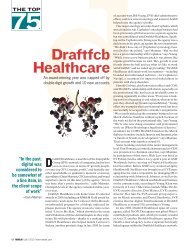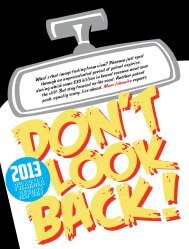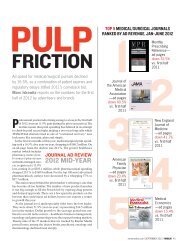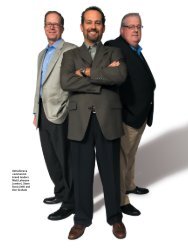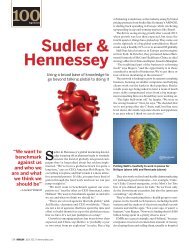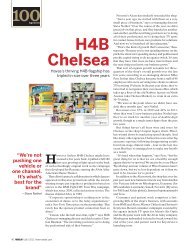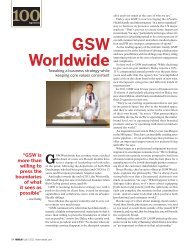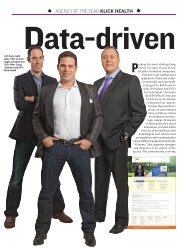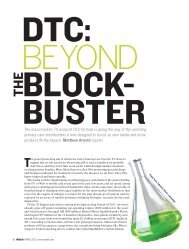LOOK - Medical Marketing and Media
LOOK - Medical Marketing and Media
LOOK - Medical Marketing and Media
You also want an ePaper? Increase the reach of your titles
YUMPU automatically turns print PDFs into web optimized ePapers that Google loves.
don’t DL D L<br />
2013<br />
don’t<br />
PHARMA<br />
REPORT<br />
What’s that image fading from view? Pharma just sped<br />
through an unprecedented period of patent expiries,<br />
during which some $30 billion in br<strong>and</strong> revenue went over<br />
the cliff. But stay focused on the road. Another patent<br />
peak, equally scary, lies ahead. Marc Iskowitz reports<br />
<strong>LOOK</strong>!<br />
<strong>LOOK</strong><br />
BACK!<br />
BACK
The sluggish economy, combined with what Michael Kleinrock,<br />
director, research development for the IMS Institute,<br />
calls “an unprecedented period of patent expiries,” led to a<br />
drop in overall drug spend of 1% last year to $325.8 billion—the<br />
first time IMS had ever recorded a decrease in US drug sales.<br />
The period from 2008-2012 was the biggest-ever for expiries,<br />
says Kleinrock. Following Lipitor’s 2011 patent implosion, last<br />
year saw the demise of mega-blockbusters like Bristol-Myers<br />
Squibb’s blood thinner Plavix. The impact is evident on the<br />
following list; only half the companies grew US sales.<br />
Kleinrock expects the same minus-one growth in 2013, due to<br />
“the carryover of 2012 expiries,” before spending rebounds in<br />
2014 <strong>and</strong> then another patent peak hits. The two peaks—2011-<br />
12 <strong>and</strong> 2014-15—are relatively similar in size, with about $30<br />
billion of lost sales per year for br<strong>and</strong>s.<br />
Milder impact from expiries, breakthrough drug approvals,<br />
<strong>and</strong> healthcare reform will drive spend on prescription drugs<br />
to rise by 3-4% in 2014, IMS predicts. Growth will then fall to<br />
just over 2% in 2015 <strong>and</strong> climb again in 2016 to almost 4%.<br />
Why not a return to double-digit growth? Many new<br />
drugs target smaller patient populations. Also, generic meds<br />
accounted for 84% of prescriptions dispensed in 2012 <strong>and</strong>,<br />
in another five years or so, will probably reach 87%.<br />
“We’re at sort of a saturation point,” Kleinrock says, where<br />
“newer br<strong>and</strong>s with better efficacy will be used, <strong>and</strong> that will<br />
slow down all of these gains that generics are making.”<br />
That, <strong>and</strong> specialty drug prices, spending for which<br />
boomed 18.4% last year, according to Express Scripts. “The<br />
specialty drugs are less price-sensitive, <strong>and</strong> we will continue<br />
to see the portion of specialty medications grow in the total<br />
drug bill,” says Jeffrey Russell, North American managing<br />
director for Accenture’s life sciences practice.<br />
Revenue losses notwithst<strong>and</strong>ing, pharmas have helped<br />
shore up profitability <strong>and</strong> shareholder value by slimming<br />
down, doing mega-mergers <strong>and</strong> in-licensing products.<br />
Going forward, what capabilities will help them?<br />
“New products are the key to survival, ” says fund<br />
manager Les Funtleyder, now with Poliwogg. Some on<br />
the list are spending 17-20% of revenues on R&D. Yet,<br />
while pipelines have been looking more attractive, R&D<br />
attrition rates have risen. And due to major pressures in<br />
the pricing <strong>and</strong> reimbursement area, “The industry can<br />
no longer continue to emphasize clinical efficacy <strong>and</strong><br />
safety requirements to determine which therapies to<br />
develop,” Russell says.<br />
Comm<strong>and</strong>ing higher prices, even for personalized<br />
medicines, will take total product value <strong>and</strong> real-world<br />
evidence. If not, pricing levels will not be sustainable.<br />
“We have to do a better job when we bring new products<br />
to market,” agrees Robert Bazemore, president,<br />
Janssen Biotech. “The burden’s going to fall much<br />
more on us to demonstrate the value these products<br />
really add.”<br />
Janssen biologics like Remicade helped parent<br />
Johnson & Johnson keep US losses in check <strong>and</strong> to<br />
grow global revenue. But with Remicade due to hit<br />
the patent wall in 2014, the company exemplifies the<br />
pressure the industry faces.<br />
“Many expected industry growth to decline much<br />
more than it actually has ended up doing,” concludes<br />
Kleinrock. “To keep it at only -1% is a pretty big<br />
success in a number of ways.”<br />
With additional reporting by Matthew Arnold,<br />
Deborah Weinstein <strong>and</strong> Kevin McCaffrey<br />
DON T<br />
AbbVie 44<br />
Actavis 45<br />
Amgen 43<br />
<strong>LOOK</strong><br />
AstraZeneca 41<br />
Boehringer Ingelheim 45<br />
Bristol-Myers Squibb 44<br />
Eli Lilly 43<br />
Gilead 46<br />
BACK<br />
GlaxoSmithKline 42<br />
Johnson & Johnson 44<br />
Merck 40<br />
Mylan 45<br />
Novartis 40<br />
Novo Nordisk 46<br />
Otsuka 46<br />
Pfizer 40<br />
Roche 42<br />
Sanofi 44<br />
Takeda 46<br />
Teva 41DON’T
PHARMA REPORT 2013<br />
1 Novartis $20.0B t1.2%<br />
Global revenue:<br />
$56.7B (3rd); down 3.2%<br />
Top br<strong>and</strong>s: Diovan<br />
($2.1B), Gleevec ($1.7B),<br />
Diovan HCT ($1.4B), Gilenya<br />
($852M)<br />
Promotional spend:<br />
$852M (6th); 4.3% of rev.<br />
40 MM&M x MAY 2013 x mmm-online.com<br />
R&D spend: $9.1B (1st);<br />
down 1.1%; 16.1% of rev.<br />
Planned launches:<br />
SOM230 (onc.), Relaxin<br />
(HF), QVA149 (resp.),<br />
NVA237 (resp.)<br />
Patent expirations:<br />
Myfortic (2013), Zometa<br />
(2013), S<strong>and</strong>ostatin (2014)<br />
Although a weak cold <strong>and</strong> flu season didn’t help matters, fewer sneezes<br />
weren’t the only reason for falling 2012 sales. The OTC division<br />
continued to stumble, paralyzed by the shuttered Lincoln, Neb., site over<br />
manufacturing problems that kept medicines off shelves. Pharmaceuticals,<br />
which powers the other five divisions, saw sales slide 1% to $32.2<br />
billion due to generics. Despite the onslaught of negatives, the company<br />
has a strong rep as a powerhouse, particularly in niche categories, <strong>and</strong><br />
the company predicted in November 2012 that sales will rebound from<br />
the Diovan patent loss (2012). Analysts are split on how, <strong>and</strong> if, Biogen<br />
Idec’s new MS drug, Tecfidera, will threaten Gilenya’s sales, but the company<br />
told investors in November that the future includes 138 potential<br />
therapies <strong>and</strong> around 10 regulatory filings with seven approvals this year.<br />
Novartis expects this to be a foundational year with single-digit sales<br />
growth in 2014 <strong>and</strong> 2015.<br />
2 Merck $19.8B t0.3%<br />
Global revenue:<br />
$47.3B (5th); down 1.5%<br />
Top br<strong>and</strong>s: Januvia ($4B);<br />
Singulair ($3.8B); Zetia<br />
($2,5B); Remicade ($2B);<br />
Vytorin ($1.7B)<br />
Promotional spend:<br />
$1.39B (3rd), 7.0% of rev.<br />
R&D spend: $7.8B (4th),<br />
down 1.3%; 16.5% of rev.<br />
Planned launches:<br />
Bridion (neuromusc. block);<br />
V503 (HPV); Atozet (lipid)<br />
Patent expirations:<br />
Remicade (2014), Zetia<br />
(2016), Vytorin (2017)<br />
It’s been a difficult time for Merck. Niacin-statin combo Tredaptive<br />
was pulled in Europe, <strong>and</strong> the Singulair allergy blockbuster came<br />
off-patent last year. First-quarter 2013 brought news that osteoporosis<br />
c<strong>and</strong>idate odanacatib is delayed. Moreover, IMPROVE-IT, the trial of<br />
combo cholesterol med Vytorin, was allowed to run its course but may<br />
not matter much in the end due to the patent window <strong>and</strong> availability<br />
of generic statins, <strong>and</strong> a possible link to pancreatitis may affect prescribers’<br />
enthusiasm for top seller Januvia. Analysts have high hopes for new<br />
R&D chief Roger Perlmutter, who comes with a proven track record<br />
from Amgen. Merck’s bet on the future lies in part with anacetrapib, an<br />
HDL-lowering treatment that the industry is skeptical of—Phase III trial<br />
data will not come until 2017. Merck is likely to receive approval for sleep<br />
therapy suvorexant in late June/early July, but Bernstein Research analyst<br />
Tim Anderson wrote in an investor note, “It is very difficult to get excited<br />
about this opportunity, (given the crowded nature of the sleep market).”<br />
Fig. 1: Top 20 Pharmaceutical Companies by US Sales ‘12<br />
Rank Company 2012 Total 2011 Total<br />
(Billions) (Billions)<br />
1 Novartis $20.0 $20.2<br />
2 Merck $19.8 $19.8<br />
3 Pfizer $18.2 $26.1<br />
4 AstraZeneca $17.3 $20.4<br />
5 Teva $16.3 $15.6<br />
6 Roche $15.4 $14.6<br />
7 GlaxoSmithKline $14.1 $14.7<br />
8 Lilly $14.0 $15.3<br />
9 Amgen $13.9 $13.4<br />
10 Abbott* $12.5 $12.0<br />
11 Sanofi $12.1 $12.4<br />
12 Johnson & Johnson $12.0 $12.1<br />
13 Bristol-Myers Squibb $8.3 $12.0<br />
14 Boehringer Ingelheim $7.9 $7.2<br />
15 Actavis $7.7 $6.0<br />
16 Mylan $7.3 $5.8<br />
17 Gilead $6.7 $5.6<br />
18 Novo Nordisk $6.6 $5.4<br />
19 Otsuka $6.0 $5.3<br />
20 Takeda $5.5 $7.1<br />
Total others $84.4 $78.0<br />
Total market $325.8 $329.2<br />
Source: IMS Health, National Sales Perspectives *On January 2, 2013, Abbott’s research-based pharma business,<br />
AbbVie, became a separate entity<br />
3 Pfizer $18.2B t30.2%<br />
Global revenue:<br />
$59.0B (2nd); down 9.6%<br />
Top br<strong>and</strong>s: Lipitor<br />
($2.0B), Celebrex ($2.0B),<br />
Lyrica ($2.0B), Viagra<br />
($1.1B), Zyvox ($721M)<br />
Promotional spend:<br />
$1.6B (2nd); 8.8% of rev.<br />
R&D spend: $7.9B (3rd)<br />
down 13.2%; 13.4% of rev.<br />
Planned launches:<br />
Celebrex (pain, 2014),<br />
Premarin (2015), Zyvox<br />
(2015)<br />
Patent expirations:<br />
Celebrex (pain, 2014), Premarin<br />
(2015), Zyvox (2015)<br />
H aving sold its infant nutrition unit to Nestle <strong>and</strong> spun off its animal<br />
health business, Pfizer brass is now turning to fixing its core pharma<br />
business <strong>and</strong> taking tentative steps toward a possible breakup into<br />
“innovative (new drugs)” <strong>and</strong> “value (mature <strong>and</strong> off-patent meds)”<br />
companies through separate management <strong>and</strong> reporting structures.<br />
Pfizer has several years to go before it’s fully over the patent cliff, <strong>and</strong><br />
there are several big shoes left to drop in the next couple of years.<br />
Analysts <strong>and</strong> investors are bullish on Ian Read’s stewardship of the<br />
company, in good measure because of increased dividends. More<br />
importantly, Pfizer’s pipeline is producing, particularly in oncology,<br />
where the firm has seen a string of approvals including Bosulif, Inlyta,<br />
Sutent <strong>and</strong> Xalkori—not to mention recent FDA approvals of RA drug<br />
Xeljanz <strong>and</strong> clot-buster Eliquis, a co-market with BMS. Wild cards could<br />
include early decisions on breast cancer c<strong>and</strong>idate palbociclib or its<br />
meningitis B vaccine.
PHARMA REPORT 2012<br />
4 AstraZeneca $17.3B t15.2%<br />
Global revenue:<br />
$28.0B (8th); down 16.7%<br />
Top br<strong>and</strong>s: Crestor<br />
($3.1B); Nexium ($2.2B);<br />
Symbicort ($1B); Onglyza<br />
($237M); Brilinta ($19M)<br />
Promotional spend:<br />
$1.1B (4th); 6.4% of rev.<br />
R&D spend: $4.5B (9th);<br />
down 10.0%; 16.1% of rev.<br />
Planned launches:<br />
Brodalumab (RA/psoriasis),<br />
fostamatinib (arthritis),<br />
lesinurad (gout)<br />
Patent expirations:<br />
Symbicort (2014); Nexium<br />
(2015); Synagis (2015)<br />
It’s been a wild year at AstraZeneca. CEO Pascal Soriot, who came<br />
from Roche last August, has wasted little time putting his mark on the<br />
company. In January, he fired the firm’s heads of commercial operations<br />
<strong>and</strong> R&D. Soriot forecasted a 2013 revenue decline in the “mid-to-high<br />
single digits” <strong>and</strong> vowed to jolt the company’s “consensus-driven” <strong>and</strong><br />
“conservative” culture. In March, the company announced another<br />
sweeping round of layoffs <strong>and</strong> office closings, moving much of its US<br />
sales <strong>and</strong> marketing functions in with MedImmune <strong>and</strong> its global headquarters<br />
from London to Cambridge, UK (which is kind of the Cambridge,<br />
MA, of Engl<strong>and</strong>). It’s all part of Soriot’s efforts to shed the firm’s<br />
small molecule-focused <strong>and</strong> inward-facing past in favor of a more collaborative<br />
<strong>and</strong> biotech-driven future. The company’s diabetes partnership<br />
with Bristol-Myers Squibb is the lynchpin of its near-term commercial<br />
plan, <strong>and</strong> about half its Phase I <strong>and</strong> II pipeline is comprised of biologics.<br />
Fig. 2: Top 20 Prescription Drugs by US Sales ‘12<br />
Rank Product Company 2012 Total 2011 Total<br />
(Billions) (Billions)<br />
1 Nexium AstraZeneca $6.0 $6.4<br />
2 Abilify Otsuka/BMS $5.9 $5.3<br />
3 Crestor AstraZeneca $5.1 $4.6<br />
4 Advair Diskus GlaxoSmithKline $4.9 $4.8<br />
5 Cymbalta Eli Lilly $4.7 $3.8<br />
6 Humira Abbott* $4.6 $3.7<br />
7 Enbrel Amgen $4.3 $3.8<br />
8 Remicade Johnson & Johnson $3.9 $3.5<br />
9 Copaxone Teva $3.6 $3.2<br />
10 Neulasta Amgen $3.5 $3.3<br />
11 Singulair Merck $3.3 $4.8<br />
12 Rituxan Genentech/Roche $3.2 $3.0<br />
13 Plavix Bristol-Myers Squibb $3.0 $7.1<br />
14 Atripla BMS/Gilead $2.9 $2.6<br />
15 Spiriva H<strong>and</strong>ihaler Boehringer Ingelheim $2.8 $2.5<br />
16 Oxycontin Purdue $2.8 $2.9<br />
17 Januvia Merck $2.7 $2.2<br />
18 Avastin Genentech/Roche $2.7 $2.7<br />
19 Lantus Sanofi $2.3 $2.1<br />
20 Truvada Gilead $2.3 $2.0<br />
Total others $240.8 $246.4<br />
Total market $325.8 $329.2<br />
Source: IMS Health, National Sales Perspectives<br />
*On January 2, 2013, Abbott’s research-based pharma business, AbbVie, became a separate entity<br />
5 Teva $16.3B s4.2%<br />
Global revenue:<br />
$20.3B (10th); up 11.0%<br />
Top br<strong>and</strong>s: Copaxone<br />
($3.6B); Proair HFA ($1.1B),<br />
Budesonide ($944M),<br />
Tre<strong>and</strong>a ($606M)<br />
Promotional spend:<br />
$289M (15th); 1.8% of rev.<br />
R&D spend: $1.4B (18th);<br />
up 27.3%; 6.9% of rev.<br />
Planned launches:<br />
Tevagrastim (onc.), laquinimod<br />
(MS), SA GCSF (onc.)<br />
Patent expirations:<br />
Azilect (2013), Tre<strong>and</strong>a<br />
(2013), Copaxone (2014)<br />
T eva progressed toward its 2011 goal to be known for br<strong>and</strong>s more<br />
than generics: generics contributed 51% of revenues while specialty,<br />
like the blockbuster Copaxone, brought in 40%. That’s a reversal from<br />
2011, when generics were the heavier-lifters at 56% with specialty drugs<br />
the relative lightweights at 35%. Yet the turnaround is still largely dependent<br />
on br<strong>and</strong>ed drugs that came over with the 2011 Cephalon purchase,<br />
<strong>and</strong> those have a short patent window ahead: Oncology drug Tre<strong>and</strong>a<br />
goes generic next year, with sleep med Nuvigil following in 2016. Despite<br />
its increased emphasis on non-generics, the company remains invested<br />
in the business <strong>and</strong> expects to grind out 23 new ones in 2013, as it did in<br />
2012. Future plans include upping its focus on CNS, respiratory drugs <strong>and</strong><br />
new therapeutic entities, while at the same time pursuing a program that<br />
could slash $2 billion in costs over the span of three to five years.<br />
Fig. 3: Top 20 Therapeutic Classes by US Sales ‘12<br />
Rank Categories 2012 Total 2011 Total<br />
(Billions) (Billions)<br />
1 Oncologics $25.9 $24.0<br />
2 Mental Health $23.5 $29.7<br />
3 Respiratory Agents $22.1 $21.7<br />
4 Antidiabetics $22.0 $20.5<br />
5 Pain $18.2 $17.9<br />
6 Lipid Regulators $16.9 $21.3<br />
7 Autoimmune Diseases $14.8 $12.5<br />
8 Antihypertensives $13.6 $14.0<br />
9 HIV Antivirals $11.7 $10.4<br />
10 ADHD $10.4 $9.2<br />
11 Anti-Ulcerants $10.0 $10.5<br />
12 Multiple Sclerosis $8.9 $7.6<br />
13 Antibacterials $7.9 $9.3<br />
14 Nervous System Disorders $7.2 $6.9<br />
15 Vaccines $6.8 $6.4<br />
16 Hormonal Contraception $5.5 $5.2<br />
17 Other CNS $5.0 $4.8<br />
18 Immunostimulants $4.7 $4.6<br />
19 Antivirals, excl. Anti-HIV $4.5 $3.8<br />
20 Platelet Aggregation Inhibitors $4.4 $8.2<br />
Total others $82.0 $80.9<br />
Total market $325.8 $329.2<br />
Source: IMS Health, National Sales Perspectives<br />
*On January 2, 2013, Abbott’s research-based pharma business, AbbVie, became a separate entity<br />
mmm-online.com x MAY 2013 x MM&M 41
PHARMA REPORT 2013<br />
Fig 4: US Spend for Total Promo, DTC, eDetailing, Professional Detailing, Professional Meetings, Journal Ads<br />
Total Promo Spend DTC eDetailing<br />
Rank Company 2012 % change 2012 % change 2012 % change<br />
(Millions)* vs 2011 (Millions) vs 2011 (Millions) vs 2011<br />
1 Eli Lilly $1,669.00 -10.0% $453.00 -8.0% $10.00 87.0%<br />
2 Pfizer $1,610.00 -24.0% $597.00 -31.0% $26.00 40.0%<br />
3 Merck $1,394.00 3.0% $288.00 25.0% $14.00 0.0%<br />
4 AstraZeneca $1,111.00 -12.0% $207.00 -38.0% $10.00 -2.0%<br />
5 Boehringer Ingelheim $986.00 15.0% $175.00 -8.0% $5.00 47.0%<br />
6 Forest Laboratories $863.00 8.0%
PHARMA REPORT 2010<br />
Detailing Meetings Journal<br />
2012 % change 2012 % change 2012 % change Company Rank<br />
(Millions) vs. 2011 (Millions) vs. 2011 (Millions) vs. 2011<br />
$640.00 -10.0% $61.00 -19.0% $1.98 -74.0% Eli Lilly 1<br />
$888.00 -19.0% $90.00 -23.0% $3.60 -35.0% Pfizer 2<br />
$975.00 -1.0% $114.00 -2.0% $0.67 -42.0% Merck & Co. 3<br />
$791.00 -1.0% $100.00 7.0% $0.67 -5.0% AstraZeneca 4<br />
$704.00 21.0% $96.00 25.0% $3.34 -20.0% Boehringer Ingelheim 5<br />
$743.00 7.0% $96.00 33.0% $7.35 -34.0% Forest Laboratories 6<br />
$663.00 -33.0% $94.00 -22.0% $1.72 -61.0% Novartis 7<br />
$607.00 -16.0% $48.00 -43.0% $1.45 0.0% GlaxoSmithKline 8<br />
$457.00 1.0% $71.00 4.0% $2.17 -14.0% Abbott 9<br />
$522.00 0.0% $97.00 32.0% $4.52 22.0% Bristol-Myers Squibb 10<br />
$352.00 15.0% $95.00 27.0% $4.32 20.0% Johnson & Johnson 11<br />
$434.00 -16.0% $50.00 -22.0% $0.87 -64.0% Takeda 12<br />
$459.00 11.0% $34.00 0.0% $0.27 -61.0% Daiichi Sankyo 13<br />
$135.00 -3.0% $59.00 22.0% $0.97 -31.0% Amgen 14<br />
$320.00 -9.0% $57.00 -12.0% $0.84 -80.0% Sanofi 15<br />
$282.00 6.0% $51.00 6.0% $2.27 -33.0% Novo Nordisk 16<br />
$129.00 -1.0% $14.00 -27.0% $0.77 -45.0% Allergan 17<br />
$201.00 -10.0% $39.00 27.0% $0.67 49.0% Sunovion 18<br />
$198.00 -22.0% $46.00 30.0% $0.23 -21.0% Teva 19<br />
$123.00 -17.0% $59.00 14.0% $2.84 -11.0% Roche 20<br />
8 Eli Lilly $14.0B t8.5%<br />
Global revenue:<br />
$22.6B (9th); down 7.0%<br />
Top br<strong>and</strong>s: Cymbalta<br />
($3.9B), Humalog ($1.4B),<br />
Alimta ($1.1B), Cialis<br />
($782M), Evista ($700M)<br />
Promotional spend:<br />
$1.7B (1st); 11.9% of rev.<br />
R&D spend: $5.3B (8th);<br />
up 5.1%; 23.4% of rev.<br />
Planned launches:<br />
Enzastaurin (onc), ramucirumab<br />
(onc), dulaglutide<br />
(diab), empagliflozin (diab.)<br />
Patent expirations:<br />
Humalog (2013), Cymbalta<br />
(2014), Evista (2014),<br />
Alimta (2017)<br />
Indiana drug maker Eli Lilly is having a time of it. Despite being among<br />
the top R&D spenders in Bernstein analyst Tim Anderson’s portfolio,<br />
the company has experienced a series of disappointments. Among<br />
them: tossing experimental drug tabalumab on the RA dust heap in<br />
2012, weakened diabetes medication sales, <strong>and</strong> being pinched by generic<br />
Zyprexa (schizophrenia). Plus, the company’s 2013 launch slate is a goose<br />
egg. Yet Anderson is intrigued by the pipeline’s potential upside. Among<br />
the treatments getting his attention is Ph.III oncology drug ramucirumab,<br />
data for which is expected this year. He also wrote in March that the<br />
company is “historically a good R&D company,” <strong>and</strong> has the chance to<br />
transform itself. As ISI’s Mark Schoenebaum told investors, “If they execute…<br />
Lilly is the only company that in two or three years will have one<br />
of every br<strong>and</strong>ed diabetes drug… That’s going to be very powerful when<br />
you go to payers <strong>and</strong> governments.”<br />
9 Amgen $13.9B s3.5%<br />
Global revenue:<br />
$17.3B (13th); up 10.9%<br />
Top br<strong>and</strong>s: Enbrel<br />
($4.0B), Neulasta ($3.2B),<br />
Epogen ($1.9B), Neupogen<br />
($1.0B), Aranesp ($782M)<br />
Promotional spend:<br />
$432M (12th); 3.1% of rev.<br />
R&D spend: $3.8B (11th);<br />
up 18.8%; 22.0% of rev.<br />
Planned launches:<br />
AMG145 (lipids), brodalumab<br />
(infla.), AMG-386 (onc.)<br />
Patent expirations:<br />
Neupogen (2013), Neulasta<br />
(2013), Vectibix (2017),<br />
Xgeva (2017), Prolia (2017)<br />
B iologics thrust it into biotech’s big leagues but, while Amgen locked<br />
up exclusivity for mega-blockbuster Enbrel until 2028 (<strong>and</strong> took over<br />
US field sales from Pfizer last year), a chunk of its biologics portfolio is<br />
staring down the patent cliff. New CEO Robert Bradway wants to st<strong>and</strong><br />
his ground against the threat of biosimilars while joining the fray as a biosimilars<br />
participant. So, he’s building the business globally while packing<br />
the pipeline with six biosimilars, due to be launched starting in 2017. The<br />
rest of Amgen’s late-stage pipeline ranges from a PCSK9 agent for hardto-treat<br />
cholesterol (AMG-145), to T-VEC, which could be an attractive<br />
option for melanoma patients. One setback was the FDA’s refusal last<br />
year to allow Amgen to exp<strong>and</strong> the approval for its Xgeva bone drug into<br />
pre-metastases bone cancer. But Xgeva, <strong>and</strong> its denosumab-based cousin<br />
Prolia, saw combined global sales of $1.2 billion for 2012, <strong>and</strong> officials<br />
said they expect the pair to exceed $3 billion.<br />
mmm-online.com x MAY 2013 x MM&M 43
PHARMA REPORT 2013<br />
Fig. 5: Estimated US Patent Expirations through 2014<br />
Br<strong>and</strong> Company Indication Expiry<br />
Aciphex Eisai/Janssen Heartburn 2013<br />
Humalog Eli Lilly Diabetes 2013<br />
Neupogen Amgen Low neutrophil count 2013<br />
Oxycontin Purdue Pain 2013<br />
Xeloda Roche Cancer 2013<br />
Zometa Novartis Osteoporosis 2013<br />
Actonel Sanofi Osteoporosis 2014<br />
Celebrex Pfizer Pain 2014<br />
Copaxone Teva Multiple sclerosis 2014<br />
Cymbalta Eli Lilly Depression 2014<br />
Evista Eli Lilly Osteoporosis 2014<br />
Nexium AstraZeneca Heartburn 2014<br />
Source: Barclays Research<br />
10 AbbVie $12.5B s4.1%<br />
Global revenue:<br />
$18.4B (11th); up 5.7%<br />
Top br<strong>and</strong>s: Humira<br />
($4.4B), AndroGel ($1.2B),<br />
Tricor/Trilipia ($1.1B)<br />
Promotional spend:<br />
$828M (8th); 6.6% of rev.<br />
44 MM&M x MAY 2013 x mmm-online.com<br />
R&D spend: $2.8B (14th);<br />
up 6.1%; 15.1% of rev.<br />
Planned launches:<br />
ABT- 267/333/450 (HCV),<br />
GLP-G0634 (infl.), BT-061/<br />
Tregalizumb (infl.)<br />
Patent expirations: Niaspan<br />
(2013), Triplix (2013)<br />
Spin-off AbbVie entered 2013 with a Humira-centric focus. The RA<br />
blockbuster is the company cornerstone as it looks for traction in<br />
specialty care. Projects include treatments for MS <strong>and</strong> multiple myeloma<br />
as well as an experimental interferon-free hepatitis C treatment. While<br />
this could be big for hep. C, Bernstein analyst Tim Anderson notes that<br />
AbbVie has more pills than rival Gilead <strong>and</strong> Bristol Myers Squibb treatments.<br />
Meanwhile, Humira accounts for about half of AbbVie’s sales, <strong>and</strong><br />
the company still pours money into exp<strong>and</strong>ing its indication reach. While<br />
this dependency has some on edge, the FDA <strong>and</strong> states are wrangling over<br />
biosimilars, possibly cushioning the impact of its 2017 patent expiration.<br />
11 Sanofi $12.1B t2.3%<br />
Global revenue:<br />
$45.6B (6th); up 4.1%<br />
Top br<strong>and</strong>s: Lantus<br />
($3.9B), Eloxatin ($920M),<br />
Renagel/Renvela ($577M)<br />
Promotional spend:<br />
$430M (13th); 3.5% of rev.<br />
R&D spend: $6.4B (6th);<br />
down 4.0%; 14.1% of rev.<br />
Planned launches:<br />
Lemtrada (MS), Lyxumia<br />
(diab.)<br />
Patent expirations: Actonel<br />
(2013), Eloxatin (2013)<br />
Sanofi not only survived a nasty plunge off a particularly steep patent<br />
cliff in 2012 but managed to grow a respectable 4.7%, despite the loss<br />
of clot-buster Plavix. The French giant, which last year overtook Pfizer as<br />
the world’s biggest pharma, boasts a packed late-stage pipeline, thanks<br />
in good measure to its acquisition of Genzyme two years ago—<strong>and</strong> with<br />
top-selling Lantus (diabetes) nearing the end of its patent life in the US,<br />
they’d better hope some of those c<strong>and</strong>idates pan out. The company has<br />
won some recent FDA approvals—for MS drug Aubagio <strong>and</strong> Kynamro,<br />
for an inherited cholesterol disorder—<strong>and</strong> has several more, including<br />
Lyxumia, for type 2 diabetes, <strong>and</strong> Lemtrada, for MS, filed with FDA.<br />
12 Johnson & Johnson $12.0B t0.7%<br />
Global revenue:<br />
$67.2B (1st); up 3.4%<br />
Top br<strong>and</strong>s: Remicade<br />
($3.6B), Procrit ($805M),<br />
Prezista ($672M), Stelara<br />
($627M), Concerta ($609M)<br />
Promotional spend:<br />
$541M (10th); 4.5% of rev.<br />
R&D spend: $7.7B (5th);<br />
up 1.6%; 11.4% of rev.<br />
Planned launches:<br />
Simeprevir (HCV), ibrutinib<br />
(onc.)<br />
Patent expirations:<br />
Remicade (2014), Doxil<br />
(2014), Prezista (2016)<br />
Alex Gorsky’s J&J is looking a lot like that of former CEO Bill Weldon.<br />
In short: recalls <strong>and</strong> bad press over items as diverse as faulty glucose<br />
meters, bad hips <strong>and</strong> marketing prescription drugs for off-label uses. This<br />
is in addition to notice from the FDA in March that it’s repeating some<br />
bad manufacturing practices from 2009. Despite this, the company’s 2012<br />
balance sheets showed that most of the major declines—i.e., the 88% sales<br />
drop in Levaquin sales—are more in line with typical patent issues than<br />
reputational ones, but failures like that of bapineuzumab (Alzheimer’s),<br />
have forced the company to slim down, in this case, by 130 employees..<br />
13 Bristol-Myers Squibb $8.3B t31.1%<br />
Global revenue:<br />
$17.6B (12th); down 17.0%<br />
Top br<strong>and</strong>s: Plavix ($2.4B),<br />
Abilify ($2.1B), Reyataz<br />
($783M), Sustiva ($1.0B),<br />
Orencia ($797M)<br />
Promotional spend:<br />
$811M (9th); 9.8% of rev.<br />
R&D spend: $3.9B (10th);<br />
up 2.6%; 22.2% of rev.<br />
Planned launches:<br />
Daclatasvir (HCV), nivolumab<br />
(onc.), elotuzumab (onc.),<br />
Forxiga (diab.)<br />
Patent expirations:<br />
Abilify (2015), Baraclude<br />
(2015), Sustiva (2015)<br />
P atent losses last year on mega-br<strong>and</strong> Plavix, as well as on Avapro<br />
<strong>and</strong> Avalide, left a revenue crater. After downsizing, BMS is vying<br />
to return to growth. The FDA rejected SGLT2 drug dapagliflozin, but<br />
Amylin—bought last year for $5.3 billion—brings Bydureon <strong>and</strong> Byetta<br />
(co-promoted with AstraZeneca) into the diabetes fold. Blood thinner<br />
Eliquis, which BMS co-markets with Pfizer, is off to a slow-but-steady<br />
launch—the Street predicts $400 million in global sales this year—<strong>and</strong><br />
analysts maintain it will eventually take the market. On the oncology<br />
front, a combo trial of melanoma drug Yervoy with Roche’s Zelboraf was<br />
stopped due to toxicity, yet potential exists to layer Yervoy with Bristol’s<br />
own anti-PD-1 agent, nivolumab, an immunotherapy. And don’t ignore<br />
BMS when it comes to hep. C—“It’s possible that BMS <strong>and</strong> Vertex could
PHARMA REPORT 2012PHARMA REPORT 2010<br />
launch a Gilead look-alike regimen [NS5A+nuc] some time in the 2016<br />
timeframe,” ISI Group’s Mark Schoenebaum recently told investors.<br />
14 Boehringer Ingelheim $7.9B s9.8%<br />
Global revenue*:<br />
$17.2B (14th); up 4.2%<br />
Top br<strong>and</strong>s: Spiriva H<strong>and</strong>ihaler<br />
($2.8B); Combivent<br />
($1.1B); Pradaxa ($871M)<br />
Promotional spend:<br />
$986M (5th); 12.5% of rev.<br />
R&D spend*: $3.3B (12th);<br />
up 2.6%; 19.1% of rev.<br />
Planned launches:<br />
Afatinib (onc.), empagliflozin<br />
(diab.)<br />
Patent expirations:<br />
Micardis (2014), Spiriva<br />
H<strong>and</strong>ihaler (2018)<br />
Boehringer’s first-to-market warfarin replacement Pradaxa is losing<br />
some of its luster as newer rivals Eliquis (Pfizer/BMS) <strong>and</strong> Xarelto<br />
(J&J/Bayer) start to siphon off share. But FDA has the anticoagulant’s<br />
back on safety worries, <strong>and</strong> that’s sure to, well, stem some of the bleeding.<br />
That’s good news for Boehringer, as its Tradjenta DPP-IV co-market<br />
with Lilly faces tough competition, <strong>and</strong> its best seller, Spiriva H<strong>and</strong>ihaler,<br />
a co-market with Pfizer worth $2.8 billion in the US, is starting to get<br />
a bit long in the teeth, despite a patent extension to 2018, while BP drug<br />
Micardis starts to lose exclusivity next year. The closely held company’s<br />
pipeline appears flush with promising c<strong>and</strong>idates for COPD, asthma <strong>and</strong><br />
pulmonary fibrosis as well as an array of oncology products.<br />
*Global revenue <strong>and</strong> R&D spend are based on the fiscal year ending<br />
December 31, 2011, the latest data available at press time.<br />
15 Actavis $7.7B s27.5%<br />
Global revenue:<br />
$5.9B (20th); up 29.0%<br />
Top br<strong>and</strong>s: Methylphenidate<br />
ER ($1.5B), atorvastatin<br />
ca ($738M), HYCD/APAP<br />
($451M), Metoprolol succin<br />
($253M)<br />
Promotional spend:<br />
$103M (17th); 1.3% of rev.<br />
R&D spend: $401.8M<br />
(19th), up 36.0%, 6.8% of rev.<br />
Planned launches:<br />
Generic versions of<br />
Lidoderm (post-herpetic<br />
neuralgia), Crestor (hyperlipidemia)<br />
Patent expirations:<br />
N/A<br />
The generics giant previously known as Watson has, in one year, shot<br />
up the ranks from the 5th to the 3rd largest generics player in the<br />
space—behind Teva <strong>and</strong> S<strong>and</strong>oz. Watson acquired Actavis this year<br />
to further build on their international visibility <strong>and</strong> even went a step<br />
further by assuming the acquiree’s name. It’s looking to sales of products<br />
like generic Lipitor <strong>and</strong> its authorized version of ADHD med Concerta<br />
to keep the ship afloat while execs work to deliver generic Crestor in<br />
2016. But with the firm’s performance tied to these anchor products,<br />
analysts warn that increased risk—including another generic version of<br />
Concerta expected later this year—could drag down 2013. There could<br />
be upside for Actavis if its generic Pulmicort, pegged for Q2 launch,<br />
actually materializes. Longer term, it has a collaboration with Amgen for<br />
biosimilar versions of Herceptin, Avastin <strong>and</strong> Rituxan/Mabthera—three<br />
of the biggest treatments in oncology.<br />
Fig. 6: New Drug Approvals 2012*<br />
Br<strong>and</strong> Company Indication Approval<br />
Voraxaze BTG International Methotrexate toxicity Jan. 17<br />
Picato Leo Pharma Actinic keratosis Jan. 23<br />
Inlyta Pfizer Renal cancer Jan. 27<br />
Erivedge Genentech B-cell carcinoma Jan. 30<br />
Kalydeco Vertex Cystic fibrosis Jan. 31<br />
Zioptan Merck Glaucoma Feb. 10<br />
Surfaxin Discovery Labs Resp. distress synd. Mar. 6<br />
Omontys Affymax Anemia Mar. 27<br />
Amyvid Avid Radiopharma Alzheimer’s diagnosis Apr. 6<br />
Stendra Vivus Erectile dysfunction Apr. 27<br />
Elelyso Pfizer Gaucher’s disease May. 1<br />
Perjeta Genentech Breast cancer Jun. 8<br />
Belviq Eisai Obesity Jun. 27<br />
Myrbetriq Astellas Overactive bladder Jun. 28<br />
Prepopik Ferring Colon cleansing Jul. 16<br />
Kyprolis Onyx Multiple myeloma Jul. 20<br />
Tudorza Pressair Forest COPD Jul. 23<br />
Zaltrap Sanofi Colorectal cancer Aug. 3<br />
Stribild Gilead HIV-1 infection Aug. 27<br />
Neutroval Sicor Biotech Neutropenia Aug. 29<br />
Linzess Forest IBS Aug. 30<br />
Xt<strong>and</strong>i Astellas Prostate cancer Aug. 31<br />
Bosulif Pfizer Leukemia Sep. 4<br />
Aubagio Sanofi Multiple sclerosis Sep. 12<br />
Choline C-11 MCPRF Prostate canc. diagn. Sep. 12<br />
Stivarga Bayer Colorectal cancer Sep. 27<br />
Jetrea Thrombogenics SVA Oct. 17<br />
Fycompa Eisai Seizures Oct. 22<br />
Synribo Ivax Leukemia Oct. 26<br />
Xeljanz Pfizer Rheumatoid arthritis Nov. 6<br />
Cometriq Exelixis Thyroid cancer Nov. 29<br />
Iclusig Ariad Leukemia Dec. 14<br />
Signifor Novartis Cushing’s disease Dec. 14<br />
Raxibacumab HGS Anthrax Dec. 14<br />
Gattex NPS Short bowel syndrome Dec. 21<br />
Juxtapid Aegerion HoFH Dec. 21<br />
Eliquis Bristol-Myers Squibb SPAF Dec. 28<br />
Sirturo Janssen Tuberculosis Dec. 28<br />
Fulyzaq Salix HIV-assoc. diarrhea Dec. 31<br />
* NMEs <strong>and</strong> new biologics approved by FDA’s Center for Drug Evaluation <strong>and</strong> Research (CDER)<br />
16 Mylan $7.3B s25.8%<br />
Global revenue:<br />
$6.8B (19th); up 11.5%<br />
Top br<strong>and</strong>s: EpiPen<br />
($508M), Fentanyl ($433M),<br />
omeprazole Rx ($278M)<br />
Promotional spend:<br />
$66M (19th); 1.0% of rev.<br />
R&D spend: $401M (20th);<br />
up 33.3%; 5.9% of rev.<br />
Planned launches:<br />
Generic versions of Lidoderm,<br />
Advair, Generess Fe<br />
Patent expirations:<br />
EpiPen (2017)<br />
mmm-online.com x MAY 2013 x MM&M 45
PHARMA REPORT 2013<br />
Analysts had seen M&A in the cards for Mylan, <strong>and</strong> the generics<br />
maker didn’t disappoint. It scooped up sterile injectable manufacturer<br />
Agila this year for $1.6 billion. The deal, after closing, is expected<br />
to make Mylan/Agila the third-biggest global player in the specialty<br />
injectable business <strong>and</strong> provide Mylan with a bigger pipeline of ANDAs.<br />
New revenue channels are important. Mylan’s top-selling EpiPen br<strong>and</strong> is<br />
facing a new threat from the launch of Sanofi’s Auvi-Q in the emergency<br />
anaphylaxis market. “Physicians forecast Auvi-Q capturing 50% share<br />
by 2016,” wrote Leerink Swann’s Jason Gerberry in an investor note. Although<br />
EpiPen volumes were down in Q1, the recent approval of Mylan’s<br />
generic Zovirax (a $230-million br<strong>and</strong>) should provide durable upside—<br />
at press time there were no competitor approvals.<br />
17 Gilead $6.7B s19.8%<br />
Global revenue:<br />
$9.7B (18th); up 15.5%<br />
Top br<strong>and</strong>s: Atripla<br />
($2.9B), Truvada ($2.3B),<br />
Viread ($542M)<br />
Promotional spend:<br />
$73M (18th); 1.1% of rev.<br />
46 MM&M x MAY 2013 x mmm-online.com<br />
R&D spend: $1.8B (17th);<br />
up 43.4%; 18.0% of rev.<br />
Planned launches:<br />
Sofosbuvir (HCV), GS7340/<br />
combos (HIV), GS-1101 (onc.)<br />
Patent expirations:<br />
Viread (2017), Atripla<br />
(2021), Truvada (2021)<br />
Gilead took flack for its expensive, $11-billion pick-up of Pharmasset<br />
<strong>and</strong> hep. C “nuc” sofosbuvir. Now, vindication is at h<strong>and</strong>. At press<br />
time, Gilead—which last year saw its “Quad” HIV pill approved—had<br />
filed a sofosbuvir-based combo pill with the FDA (an EU filing is expected<br />
in Q2). Analysts say the biotech may be first-to-market, by early<br />
2014, with a once-a-day oral drug. Street estimates st<strong>and</strong> at a billion<br />
dollars. “The real number is probably $2 billion plus,” ISI Group’s Mark<br />
Schoenebaum told investors, adding, “Fifteen thous<strong>and</strong> patients, only,<br />
treated for hep. C equals a billion dollars in sales…There are 350,000<br />
patients under the active care of a hep. C specialist right now that have<br />
been warehoused, that need therapy in the US.” AbbVie <strong>and</strong>/or BMS<br />
could follow with their own interferon-sparing pills. In trials, all have offered<br />
cure rates of over 90% for patients with a variety of HCV types.<br />
18 Novo Nordisk $6.6B s21.1%<br />
Global revenue:<br />
$13.7B (17th); up 16.7%<br />
Top br<strong>and</strong>s: NovoLog<br />
($1.2B), Levemir ($1.1B),<br />
NovoLog Flexpen ($1.1B),<br />
Victoza ($808M)<br />
Promotional spend:<br />
$426M (14th); 6.5% of rev.<br />
R&D spend: $1.9B (16th)<br />
up 6.1%; 14.0% of rev.<br />
Planned launches:<br />
Liraglutide (obesity), turoctocog<br />
alfa (hem.), Tresiba<br />
(diab.)<br />
Patent expirations:<br />
Novolog (2014), Levemir<br />
(2014), Victoza (2017)<br />
Novo Nordisk enjoyed positive returns from its diabetes franchise in<br />
2012, but recent setbacks could dampen things. Novo’s long-acting<br />
insulin Tresiba was denied by the FDA due to cardiovascular risks. And a<br />
group of researchers in March suggested a possible link between insulin<br />
mimetics (like Victoza) <strong>and</strong> pancreatitis. That said, the Danish drug<br />
maker still holds 26% of worldwide diabetes market share, <strong>and</strong> analysts<br />
predict the US delay on Tresiba will only shave 6% off earnings in the<br />
coming years (the product is launching in the EU <strong>and</strong> Japan). Novo<br />
should watch its back, though. Insulin <strong>and</strong> GLP-1 biosimilars are already<br />
in the works, <strong>and</strong> its three best-selling products—NovoLog, Levemir <strong>and</strong><br />
Victoza—are all scheduled to be off-patent by 2017.<br />
19 Otsuka $6.0B s11.8%<br />
Global revenue*:<br />
$14.0B (16th); up 6.9%<br />
Top br<strong>and</strong>s: Abilify ($5.8B),<br />
Samsca ($91M), Busulfex<br />
($11M), Pletal ($2M)<br />
Promotional spend:<br />
$27M (20th); 0.5% of rev.<br />
R&D spend*: $1.9B (15th);<br />
down 3.2%; 13.8% of rev.<br />
Planned launches:<br />
TAS-102 (onc.), OPC-34712<br />
(psych.)<br />
Patent expirations:<br />
Abilify (2015)<br />
Otsuka has been driving growth of schizophrenia drug Abilify, <strong>and</strong><br />
while new products aren’t exactly towing the line, CNS sales are<br />
holding steady. The patent on its top-seller dries up in 2015 in the US,<br />
though, where BMS h<strong>and</strong>les marketing. Meanwhile, Otsuka <strong>and</strong> Lundbeck<br />
won FDA approval for a once-monthly injectable form of Abilify<br />
that will compete with J&J’s Invega Sustenna. The Tokyo-based pharma<br />
also deepened its longtime CNS alliance with Lundbeck, agreeing to<br />
co-develop an Alzheimer’s agent with the Danish drug maker, <strong>and</strong> to exp<strong>and</strong><br />
their existing Abilify (ex-US) co-promote to 14 countries. Otsuka is<br />
also hoping to wring more out of its nutraceuticals division.<br />
* Global revenue <strong>and</strong> R&D spend are based on the fiscal year ending<br />
March 31, 2012, the latest data available at press time.<br />
20 Takeda $5.5B t22.6%<br />
Global revenue*: $15.6B<br />
(15th); down 10.9%<br />
Top br<strong>and</strong>s: Actos ($1.7B),<br />
Dexilant ($798M), Velcade<br />
($715M), Colcrys ($605M),<br />
Amitiza ($311M)<br />
Promotional spend:<br />
$507M (11th); 9.2% of rev.<br />
R&D spend*: $2.9B (13th);<br />
down 11.4%, 18.6% of rev.<br />
Planned launches:<br />
Vortioxetine (dep.), vedolizumab<br />
(inflam.), TAK-700<br />
(onc.)<br />
Patent expirations:<br />
Velcade (2018)<br />
G eneric Actos took a $1.8-billion bite out of Takeda’s US sales last<br />
year. To fill in the gap, management is looking toward the pipeline.<br />
Its Millennium unit boasts three late-stage prospects—TAK-700 for<br />
prostate cancer, MLN9708 for multiple myeloma, <strong>and</strong> Vedolizumab for<br />
ulcerative colitis—<strong>and</strong> GPR40 agonist TAK875 could give the Japanese<br />
firm another run in diabetes. But there have been setbacks. Takeda <strong>and</strong><br />
partner Affymax pulled anemia biologic Omontys due to a life-threatening<br />
adverse event, <strong>and</strong> Takeda faces a lawsuit over Actos’ alleged link to<br />
bladder cancer. The company is exploring more early-stage compounds to<br />
offset its front-loaded pipeline.<br />
* Global revenue <strong>and</strong> R&D spend are based on the fiscal year ending<br />
March 31, 2012, the latest data available at press time.



